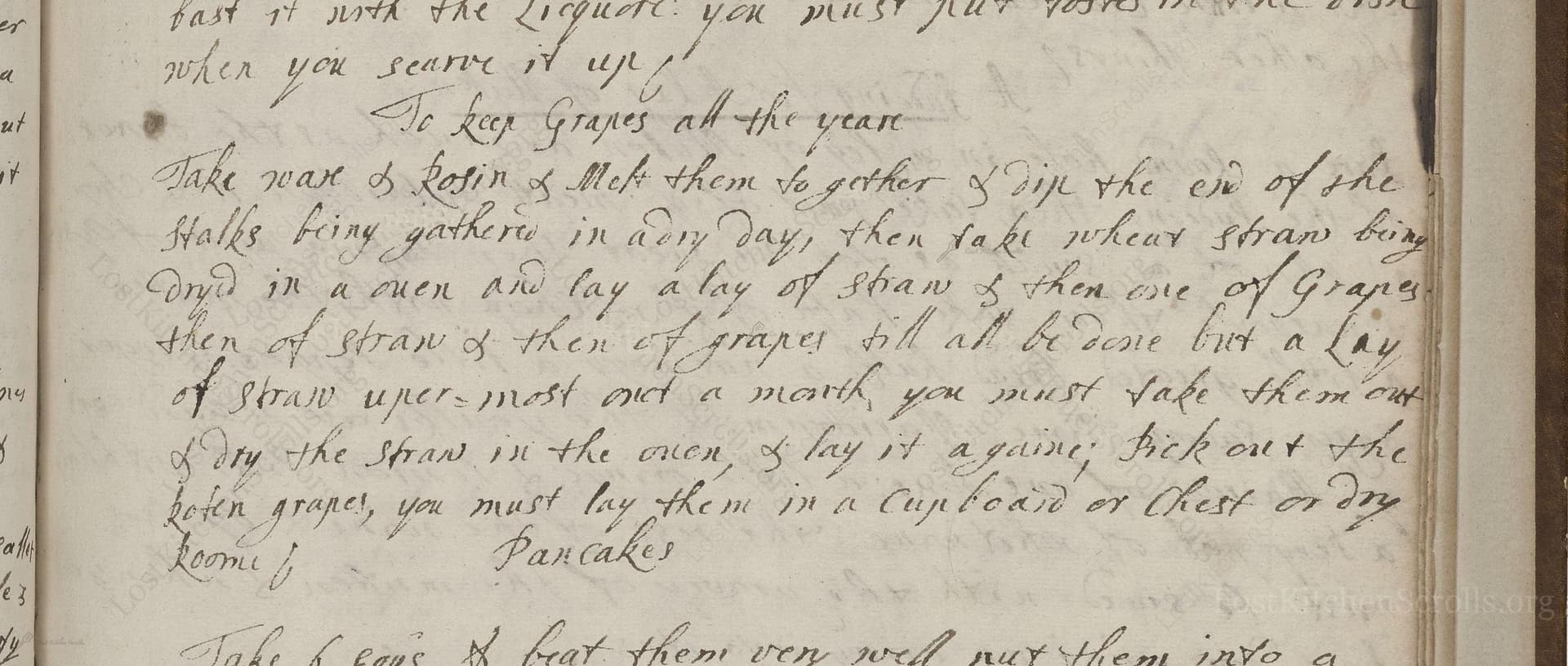To Keep Grapes All The Yeare
From the treasured pages of Receipts in cookery and medicine 1700
Unknown Author

To Keep Grapes All The Yeare
"Take waxe & Rosin & Melt them to gether & dipe the end of the stalks being gathered in a dry day, then take wheat straw being dryd in a ouen and lay a lay of straw & then one of Grapes then of straw & then one of Grapes then of straw uper-most out a month till all be done but a lay of straw uper-most out a month you must take them out & dry the straw in the ouen, & lay it a gaine; pick out the rotten grapes, you must lay them in a cupboard or Chest or dry Roome/"
Note on the Original Text
This recipe is written in the straightforward, almost conversational instructional style common to early modern English household manuscripts. Spelling is non-standard ('waxe' for wax, 'ouen' for oven, 'uper-most' for uppermost), and punctuation is sparse or irregular. Steps are not numbered but unfold cumulatively, assuming familiarity with kitchen processes. The original instructions assume knowledge of ingredient proportions and do not specify exact quantities, so some interpretation is required for modern execution. The technique is more preservation than cookery—encapsulating a tactile, hands-on approach to keeping food edible before the modern pantry.

Title
Receipts in cookery and medicine 1700 (1700)
You can also click the book image above to peruse the original tome
Writer
Unknown
Era
1700
Publisher
Unknown
Background
Step into the kitchen of the early 18th century, where this charming culinary manuscript tempts tastebuds with recipes and secrets from a bygone era. A delicious journey for both the curious cook and the history lover.
Kindly made available by
Folger Shakespeare Library
This recipe dates from around 1700 and comes from an English household manuscript, offering a method for storing grapes well past their natural season. In an era before refrigeration, resourceful cooks developed ingenious strategies to enjoy fruits like grapes throughout the year, especially to grace winter tables or special occasions. The use of beeswax and resin to seal grape stalks reflects an understanding of preventing moisture loss, while layering with straw imitates the gentle insulation of a field, reducing spoilage and bruising. Such recipes reveal both practical knowledge and the luxury of having surplus fruit—showcasing the intersection of preservation, status, and seasonality.

Cooks in 1700 would have used a hearth or open fire for gentle melting of wax and resin, likely in a small pan or earthenware pot. Tongs or a fork would assist in dipping each grape stem. Dried wheat straw would be gathered from the harvest and dried in a bread oven after baking was done, taking advantage of the residual heat. Storage would involve a wooden box, cupboard, or chest, placed in the driest part of the house. A sharp knife or shears would be needed for snipping grape clusters and picking out spoiled fruit during monthly checks.
Prep Time
30 mins
Cook Time
10 mins
Servings
1
We've done our best to adapt this historical recipe for modern kitchens, but some details may still need refinement. We warmly welcome feedback from fellow cooks and culinary historians — your insights support the entire community!
Ingredients
- 1.75 oz beeswax (food-grade)
- 1.75 oz pine resin (food-grade; rosin)
- Fresh grape clusters (as many as desired, unwashed)
- Dried wheat straw (enough to layer the container, substitute: clean baking parchment or dried hay)
Instructions
- To preserve grapes through the year, begin by gently melting together roughly equal parts of food-grade beeswax and pine resin (about 1.75 oz each).
- Dip the cut end of each grape cluster's stalk into the melted mixture, allowing it to seal and harden.
- Next, line a container or tray with thoroughly dried wheat straw—about half an inch thick—then add a single layer of dry, unwashed grapes (still on the stalks).
- Alternate layers of straw and grapes, finishing with a final layer of straw on top.
- Store this stack in a cool, dry space such as a pantry for about a month.
- After one month, carefully remove the grapes and straw.
- Dry the straw in a low oven (about 195°F) until crisp, then reassemble in the same layered fashion, discarding any spoiled or rotten grapes.
- Repeat this process monthly until all the grapes have been enjoyed, always keeping the storage area dry and well-ventilated.
Estimated Calories
70 per serving
Cooking Estimates
Preparing and dipping the grape clusters takes just a little time. Most of the process is waiting as the grapes are stored and dried each month. You don’t need to cook the grapes, just melt the wax and resin. The grapes themselves are not significantly changed, so calories will be the same as with fresh grapes.
As noted above, we have made our best effort to translate and adapt this historical recipe for modern kitchens, taking into account ingredients nowadays, cooking techniques, measurements, and so on. However, historical recipes often contain assumptions that require interpretation.
We'd love for anyone to help improve these adaptations. Community contributions are highly welcome. If you have suggestions, corrections, or cooking tips based on your experience with this recipe, please share them below.
Join the Discussion
Rate This Recipe
Dietary Preference
Main Ingredients

Den Bockfisch In Einer Fleisch Suppen Zu Kochen
This recipe hails from a German manuscript cookbook compiled in 1696, a time whe...

Die Grieß Nudlen Zumachen
This recipe comes from a rather mysterious manuscript cookbook, penned anonymous...

Ein Boudain
This recipe comes from an anonymous German-language manuscript cookbook from 169...

Ein Gesaltzen Citroni
This recipe, dating from 1696, comes from an extensive anonymous German cookbook...
Browse our complete collection of time-honored recipes



